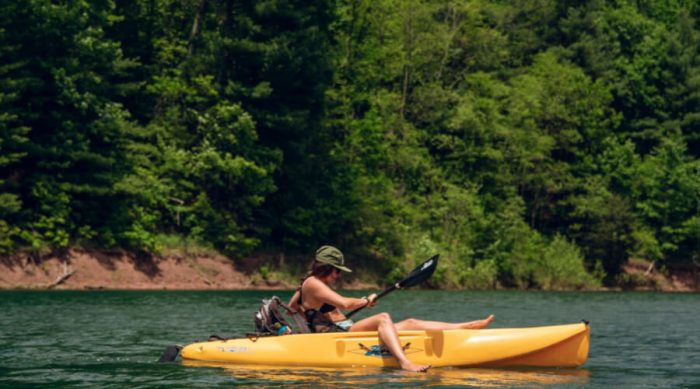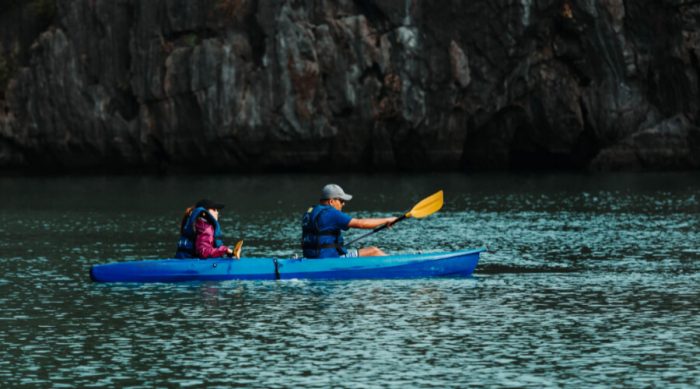Having a tippy kayak is frightening to novice and experienced paddlers since you risk capsizing at any time. Luckily, if you have an unstable kayak, you can make it more stable by getting a stabilizer system or adjusting the weight distribution on your vessel.
Key Takeaways
- In most cases, the stability of a kayak depends on its type and where you are kayaking
- If you use a flat water kayak in white water then you won’t get better stability from the kayak
- Before buying a kayak, ensure you know what it is designed for, and that it matches your need
- Weight distribution on the kayak also plays a very important role in the stability of a kayak
- If you are a beginner kayaker then you should increase your paddling and stability skills
What Makes A Kayak Unstable?

Several factors determine how stable a kayak is. Some are design issues while others depend on the paddler’s skill; some kayaks are designed to remain stable on flat water and are great for recreational purposes. Other kayaks are designed for white water and are not the most stable for flat water. You need to ensure you have the right kayak for your type of activity; otherwise, it will be a task to make a kayak stable for the wrong use. Here are the reasons why your kayak might be unstable:
1. The Wrong Type Of Kayak For Your Type Of Activity
If you find that your kayak always feels unsteady every time you hit the water, you might be using the wrong type of kayak. Various kayaks are designed for different water conditions; their width and hull shapes are customized for specific water activities.
Before buying a kayak, ensure you know what it is designed for, and it matches your need. Determine what you intend to use the kayak for even before you buy. For example, if you want a kayak for leisure trips on calm water, choose one with a wide hull and a flat bottom; if you’re going to explore fast-moving water such as rivers, a slim and short kayak will be best.
It would be best to consider the shape and width of the kayak before buying to make sure they match your intended use. Wide kayaks with a flat hull are appropriate for beginners and anyone looking to kayak on flat water. If you want to slice through rough water and currents, you will need a hull designed to handle that.
2. Improper Weight Distribution On The Kayak
Another factor often overlooked when determining why a kayak is unstable is the weight distribution. How the weight of people and luggage is distributed on a kayak plays a significant role in determining whether the kayak will wobble or not. If there’s an excessive amount of weight on one side of the boat, your kayak will not be balanced. This means you will struggle to keep the vessel afloat and stable. Paddling a kayak whose weight is not evenly distributed is extremely exhausting and also risky.
3. Lack Of Experience By The Paddler
Another common reason why a kayak may be unstable is an inexperienced paddler steering the kayak. Different paddlers will experience other stability challenges when paddling in the same environment using the same kayak. Your level of skill and ability to handle various water conditions determine how stable your kayak will be. Before you start kayaking, ensure you have mastered the basic skills, then keep perfecting your techniques to keep your kayak stable at all times.
Five Tips To Make Your Kayak More Stable.

If you are confident that you have the right kayak for your activity but are still struggling to keep it stable, you need to take action. Below are some of the ways you can make your vessel more stable on the water:
1. Ensure There’s Equal Weight Distribution On Your Kayak
Before heading out on a kayaking trip, always ensure that your weight and passengers, and gear are evenly distributed. Too much weight on one side of the kayak can make it wobble or even tip over. If your kayak has multiple storage areas, spread gear to different sides of the boat to ensure it’s not overloaded on one side.
2. Alter The Kayak’s Centre Of Gravity By Lowering The Seat
Lowering the seat of your kayak is one of the fastest and most efficient methods of improving stability known to paddlers. By lowering your seat position, you change the vessel’s center of gravity and also feel more secure. At first, you might struggle to paddle in this position, but once you master it, the stability that comes with it is worth the effort.
3. Work On Your Paddling And Stability Skills
When you are just starting, you will feel your kayak wobble from time to time. Consider taking a kayaking class to equip you with the basic skills needed to maintain stability. After taking the course, keep practicing to perfect your skills and gain insights into handling instability in different kayaking situations. Taking a kayaking class will help you improve your skills and confidence, and you will be able to handle whatever the water throws at you.
4. Attach Kayak Outriggers
Outriggers or kayak stabilizers are an instant method of improving your kayak’s stability on the water. These are pontoon or balloon-like protrusions added on each side of the kayak to add buoyancy and stability. They help keep the kayak from tipping side to side and are pretty affordable and easy to install.
5. Try A Different Kayak
Sometimes, you might try all the methods to make your kayak more stable but with little or no success. If that happens, try a different kayak. The problem might be the kayak itself, so try something different and see how it goes. It is always advisable to try other kayak models before you buy: doing this will help you determine how different vessels perform on the water and choose the best.
We hope that these tips work to make your kayak more stable on the water. Sometimes, it will take a combination of different methods to make your kayak stop tipping. Don’t be afraid to try them out before you give up on your kayak.
Frequently Asked Questions On How To Make A Kayak Stable
Q. Is A Sit-In Or A Sit On Kayak More Stable?
Sit-on-top kayaks are designed to be more stable than sit-inside kayaks. Sit-on kayaks have a lower center of gravity, and their hulls are wider with unique bottom shapes. Most beginner kayaks are sit-on-top since they are designed for stability, and paddlers can concentrate on paddling without worrying about tipping over.
Q. Do Kayaks Capsize Easily?
No, kayaks are mostly safe to use and rarely tip over. The risk of your kayak tipping over will depend on the type of kayak and the waters where you are paddling.
Conclusion
A stable kayak is essential for your confidence and safety on the water; if your kayak is mostly wobbly on the water, you need to take action to make it more stable. However, before trying out different methods that might require financial investment, ensure you have the right kayak. Try out the tips in this article and see what works. You can combine two or more methods to achieve the desired stability for your vessel.
References:
https://www.quora.com/What-can-you-do-to-a-kayak-to-make-it-more-stable
https://www.tycoonvilla.com/how-to-make-a-kayak-more-stable/

Rockey is a kayaking enthusiast who has been kayaking with a local group for the last five years. He loves using kayaks while out on outings on the water or camping when the friends want to have a BBQ party somewhere on the bank of a local lake. More About James R Rockey at About Page Here: Authors
Based on his experiences with the different types of kayaks, he is sharing his opinion about kayaking tricks and required gears so that a beginner can get started right away.
Find his team on Twitter here. Happy reading!
